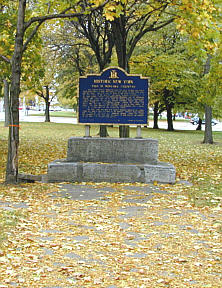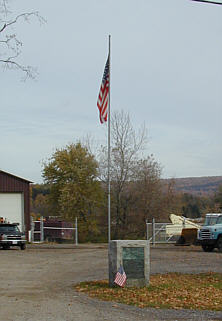UTICANEW YORK |
 |
UTICANEW YORK |
 |
 George
Washington Statue — A statue of George Washington at Valley Forge can be
found in front of the Utica Public Library. General Washington visited Utica
during a tour of the Mohawk Valley near the end of the Revolutionary War in July
1783.
George
Washington Statue — A statue of George Washington at Valley Forge can be
found in front of the Utica Public Library. General Washington visited Utica
during a tour of the Mohawk Valley near the end of the Revolutionary War in July
1783.
 Von
Steuben Statue — After the Revolutionary War, General Friedrich Wilhelm
von Steuben spent summers near Utica on land given to him in honor of his role
as “drillmaster” at Valley Forge. He is buried on Starr Hill, 20 miles north
of the city. Today, the area is the Steuben Memorial State Historic Site.
Von
Steuben Statue — After the Revolutionary War, General Friedrich Wilhelm
von Steuben spent summers near Utica on land given to him in honor of his role
as “drillmaster” at Valley Forge. He is buried on Starr Hill, 20 miles north
of the city. Today, the area is the Steuben Memorial State Historic Site.
General Friedrich Wilhelm von Steuben was the person most responsible for the transformation of the Continental Army at Valley Forge into a winter-hardened, great fighting force. He was at onetime, a member of the elite General Staff of Frederick the Great, king of Prussia. No longer in the Prussian army and without employment of any kind, von Steuben offered his military skills to the patriot cause. When he arrived at Valley Forge from France on February 23, 1778, he was armed with a letter of introduction from Benjamin Franklin. Washington saw great promise in the Prussian and almost immediately assigned him the duties of Acting Inspector General with the task of developing and carrying out an effective training program.
He formed a model company of 100 selected men and undertook its drill in person. The rapid progress of this company under von Steuben's skilled instruction set an example for the whole army. After training, the members of the company were distributed amongst the rest of the army to spread the training. This skilled Prussian drillmaster tirelessly drilled and scolded the regiments into an effective fighting force.
Slowly but steadily the endurance, bravery, and sacrifice of
the soldiers at Valley Forge began to tell. Increasing amounts of supplies and
equipment came into camp. New troops arrived. Spring brought word of the French
alliance with its guarantees of military support. Now a strong, dependable
force, well-trained and hopeful of success, emerged from the winter at Valley
Forge.
 Old
Fort Schuyler — In 1758, the British built a fort in the Utica area, one
of a chain of defenses, which extended along the Oswego-Mohawk River water route
during the French and India War. This fort was called Fort Schuyler in honor of
Colonel Peter Schuyler, uncle of the Revolutionary War General, Philip Schuyler.
The fort was abandoned in 1760.
Old
Fort Schuyler — In 1758, the British built a fort in the Utica area, one
of a chain of defenses, which extended along the Oswego-Mohawk River water route
during the French and India War. This fort was called Fort Schuyler in honor of
Colonel Peter Schuyler, uncle of the Revolutionary War General, Philip Schuyler.
The fort was abandoned in 1760.
During the Revolutionary War, Fort Stanwix was renamed Fort Schuyler in honor of Philip Schuyler. The Utica fort then became known as Old Fort Schuyler. After the war, the name Fort Stanwix was returned to the fort in Rome.
After the Battle of Oriskany, the wounded General Herkimer was brought by litter to Old Fort Schuyler, where the American survivors made camp on August 6, 1777. Here, Herkimer and other wounded were put on boats and rowed down the Mohawk to Fort Herkimer, an upcoming site on this road trip.
At the site of Old Fort Schuyler, there are two 40-Mile Markers and a Bagg’s Tavern Marker.
Lunch in Utica — A great spot for lunch, Lupino’s Trackside Restaurant, is about a block east of the markers on Main Street. The restaurant, which is one of the “Town’s Best,” specializes in Italian fare.

|
Historic New York The majestic Mohawk Valley has been the scene of many key events, which have helped to shape the character and destiny of New York State and the nation. This was once the home of the proud Mohawks, one of the main tribes of the powerful six-nation Iroquois Confederacy. As the main gateway between the Adirondack Mountains and the Allegheny Plateau, the valley came to be used by French-Catholic missionaries, land-hungry settlers moving west, foreign travelers, French and Indian raiders, British Tories and American troops. During the French and Indian War and the American Revolution, it was a vital center of action — the main highway for east-west communication and a major point of contact between the contending armies. The Erie Canal and New York Central Railroad followed the valley route and gave a new direction to its history. Internal improvements led to intensive settlement and industrial growth. While the valley has changed in many ways over the years, it still retains one element of the past — its incomparable beauty. Education Department, State of New York, 1967, Department of Transportation (Utica Marker) |
Crossing Marker -- Herkimer and his militia on their way to relieve Fort Stanwix crossed the Mohawk ford from the north bank to the south bank on August 5, 1777.
 |
At this point on August 5, 1777, General Herkimer with the greater part of his men and wagon train turned southerly to ford the Mohawk. Placed by Colonel Marinus Willet Chapter, Daughters of the American Revolution, of Frankfort, June 14, 1912. (40-Mile Route Marker) |
Camp Marker -- Herkimer and his militia made camp on the evening of August 4, 1777.
 |
General Herkimer camped near this spot on the night of August 4, 1777. With him were his 800 men and 400 ox-carts filled with supplies for the relief of Fort Stanwix. Placed by Mohawk Valley Chapter, Daughters of the American Revolution, 1912. (40-Mile Route Marker) |
